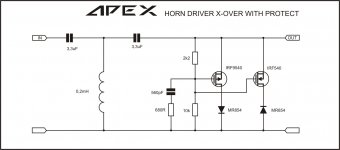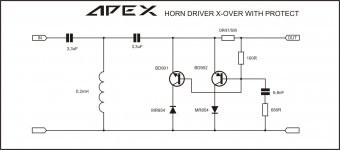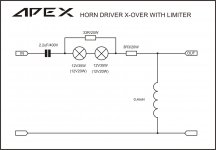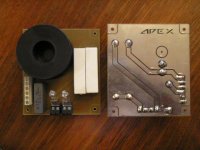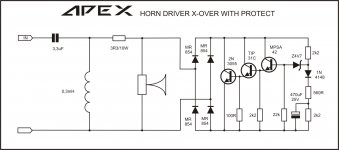"what is the reason speakers often blow ( mainly distrotrionxtime and not powerxtime"
Hey, it's fine that you think this, but it is WRONG.
"I hv designed protection circuit with 12V 35W/35W bulb.
Calculating when PTC is tripped.
Here the bulb will become 24V 70W.
DC resistance of bulb will be 8.23 ohm.
Current at full 24 volt will be 2.91A.
Assuming the tweeter to be 50W.
Hence at 20V current will be 2.5A.
Voltage drop across bulb when 2.5A pass :
V = RI i.e. 8.23 x 2.5 = 20.57V. "
What makes you think a lightbulb is a linear resistance? There is about a 20:1 ratio.
A 70W 24V (composite) bulb will probably not protect a 2.84" Nomex former driver.
Your network will not work as the bulb resistance is so low the PTC will probably not trip.
Hey, it's fine that you think this, but it is WRONG.
"I hv designed protection circuit with 12V 35W/35W bulb.
Calculating when PTC is tripped.
Here the bulb will become 24V 70W.
DC resistance of bulb will be 8.23 ohm.
Current at full 24 volt will be 2.91A.
Assuming the tweeter to be 50W.
Hence at 20V current will be 2.5A.
Voltage drop across bulb when 2.5A pass :
V = RI i.e. 8.23 x 2.5 = 20.57V. "
What makes you think a lightbulb is a linear resistance? There is about a 20:1 ratio.
A 70W 24V (composite) bulb will probably not protect a 2.84" Nomex former driver.
Your network will not work as the bulb resistance is so low the PTC will probably not trip.
Now i want to select PTC for the circuit.
PTC works differently under temperature.
So i will like to check which one suits my purpose.
I will select one out of RXE 075 or RXE 090.
Shall I test the PTC with 1Khz sinewave amplified signal or just dc voltage source will do? As a load, i will use 8 ohm 60W(assembled by series parallel) resistor.
PTC works differently under temperature.
So i will like to check which one suits my purpose.
I will select one out of RXE 075 or RXE 090.
Shall I test the PTC with 1Khz sinewave amplified signal or just dc voltage source will do? As a load, i will use 8 ohm 60W(assembled by series parallel) resistor.
"
Suggested current levels:
For 1" coils (tweeters), about 1A. The 561 or 211-2 automotive lamp has worked well in this application.
For 1-3/4" coils (1" compression drivers), about 2A. The 1156 type automotive lamp has worked well in this application.
For 3" (kapton) to 4" (nomex) coils (2" throat 16 ohm compression drivers), about 2A. I have found a 1.5A AGC (or 3AG) type fast-blow fuse will pass 400W of program material in normal use, and blow almost instantly if bad feedback is encountered. A pair of 1156 automotive lamps wired in series with each other, and then wired in parallel with the fuse will allow the show to go on when the fuse blows, and still offer some protection. If the fuse blows in the course of normal use, you need additional HF drivers, horns, and amplifiers.
For JBL 2402H, a 20W rms rating "bullet" tweeter, I assume a 561 or 211-2 lamp will be perfect protection. A parallel fuse, under 1.58A, say 1.25 or 1.0 goes in parallel. Hmmm, should i stay with 1 and not consider 1.25?
Repeating the same calculation for a JBL 2446J 16R driver, the bulbs as DJK suggest for (2" 16R) horn driver.
Now say there is is mic "feedback" and a fuse blows, can this be identified, by ear, or does the blown fuse require visual inspection?
I been trying to protect expensive tweeter and horn driver for years now. I've heard about using bulbs but never tried them, now is the time. Thanks ahead of time for any suggestions. I see the 211-2 bulbs case is similar to a fuse making mounting easy. Do I need special solder to wire 561 bulb, I read this someone in thread but now unsure?
Last edited:
A 211-2 is a 561 with end caps that are easy to solder, the 561 rigid loop is steel wire and difficult to solder (acid flux is usually needed).
For the 8Ω 20W JBL 2402/05 I would probably use the #1141, and if you want a parallel fuse, try a 1A or 1.25A fast blow type.
The bulbs I most often use:
#211-2 12.8V .97A
#1141 12.8V 1.44A
#1156 12.8V 2.1A
"Now say there is is mic "feedback" and a fuse blows, can this be identified, by ear, or does the blown fuse require visual inspection?"
If you are driving it to the max and blow a fuse, the bulb will give a visual indication by lighting up on the extreme peaks in the program material. If you just blow on a feedback squeal the bulb will probably not light up on normal program material.
For the 8Ω 20W JBL 2402/05 I would probably use the #1141, and if you want a parallel fuse, try a 1A or 1.25A fast blow type.
The bulbs I most often use:
#211-2 12.8V .97A
#1141 12.8V 1.44A
#1156 12.8V 2.1A
"Now say there is is mic "feedback" and a fuse blows, can this be identified, by ear, or does the blown fuse require visual inspection?"
If you are driving it to the max and blow a fuse, the bulb will give a visual indication by lighting up on the extreme peaks in the program material. If you just blow on a feedback squeal the bulb will probably not light up on normal program material.
What sockets are used to mount the 1141 or 1156 bulbs. I found a supplier, 1000bulbs.com but no fixtures. 211-2 mounts like a fuse so it easy to install. I need something that can be screwed down and easy to change. Sockets from automotive suppliers are too expensive and not meant to be screwed down.
My setup uses a Behringer DCX2496 electronic crossover with tweeter crossed over at ~6kHz, hafler p125 amp. Thus control over the gain and crossover type. A capacitor (10uf or more I think) is in series to block turn on/off transient (even though the p125 turn on/off quietly but subsequent Rockford Fosgate haflers do) but who know what amps may be connected at another time.
A while ago, I made my own relay protection (from an old JBL doc) basically an EV protection circuit clone using a cap and 4 diodes and a 12V relay. Some tweeters survived but although operational had cracks in the voice coil upon inspection. So occasionally my speakers system gets abuse, looking forward to going with bulbs.
My setup uses a Behringer DCX2496 electronic crossover with tweeter crossed over at ~6kHz, hafler p125 amp. Thus control over the gain and crossover type. A capacitor (10uf or more I think) is in series to block turn on/off transient (even though the p125 turn on/off quietly but subsequent Rockford Fosgate haflers do) but who know what amps may be connected at another time.
A while ago, I made my own relay protection (from an old JBL doc) basically an EV protection circuit clone using a cap and 4 diodes and a 12V relay. Some tweeters survived but although operational had cracks in the voice coil upon inspection. So occasionally my speakers system gets abuse, looking forward to going with bulbs.
OK, the standard base for 1141 and 1156 is ba15s base. It appears I need to just drill a hole the diameter of the base to mount the bulb. Maybe epoxy glue the base onto wood or plastic. The base comes with wire leads.
Just want to know if there are any other good ideas on mounting the bulb base?
Just want to know if there are any other good ideas on mounting the bulb base?
Protect with halogen lamp
For 10W nominal power drivers use 2 X 12V 10W bulbs or 24V 20W single bulb,
2 X 12V 20W bulbs is for protect 20W drivers and
2 X 12V 35W bulbs is for 50W drivers.
Last edited:
What are the cold resistances of those bulb filaments?
"What if", the bulb filament resistance is higher than the crossover resistor presently in place in the unprotected crossover?
How do we adjust the crossover resistor value/s to account for the bulb filament resistance?
"What if", the bulb filament resistance is higher than the crossover resistor presently in place in the unprotected crossover?
How do we adjust the crossover resistor value/s to account for the bulb filament resistance?
Explain in as much detail why a parallel fuse is necessary?
The bulb filament resistance is explained over and over in the thread. (I fully follow and understand).
I'm asking myself why bother with the parallel fast blow fuse. During high current (mic squeal or large crescendo), the bulb goes high resistance and the parallel fuse will pass much of the current to the driver. No protection here. Once the fuse blow, the bulb provides protection.
The bulb filament resistance is explained over and over in the thread. (I fully follow and understand).
I'm asking myself why bother with the parallel fast blow fuse. During high current (mic squeal or large crescendo), the bulb goes high resistance and the parallel fuse will pass much of the current to the driver. No protection here. Once the fuse blow, the bulb provides protection.
Any knowledge on ferrofluid? I've read it helps keep the voice coil cool and typically used on high frequency drivers and tweeters. It's available online as a replacement for drivers with worn fluid. I've read that it should NOT be used on existing non-fluid drivers.
If it increases power handling, what's the typical degradation in response look like? It appears your adding mass to the voice coil thus reducing the highest sparkle of the tweeter sound.
If it increases power handling, what's the typical degradation in response look like? It appears your adding mass to the voice coil thus reducing the highest sparkle of the tweeter sound.
- Status
- This old topic is closed. If you want to reopen this topic, contact a moderator using the "Report Post" button.
- Home
- Amplifiers
- Solid State
- tweeter ( Compression driver) protection circuit
